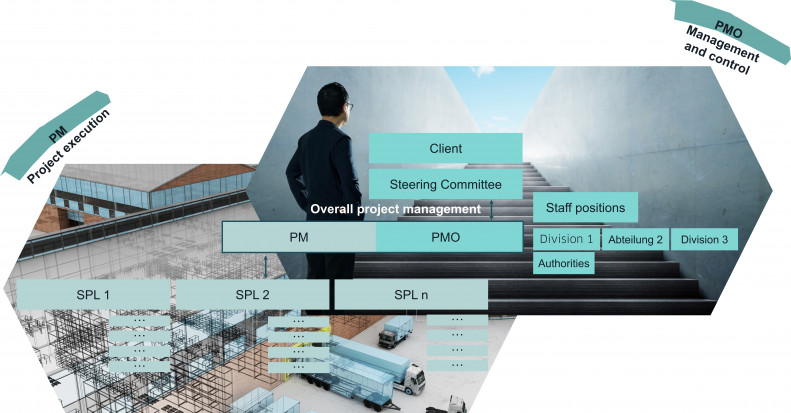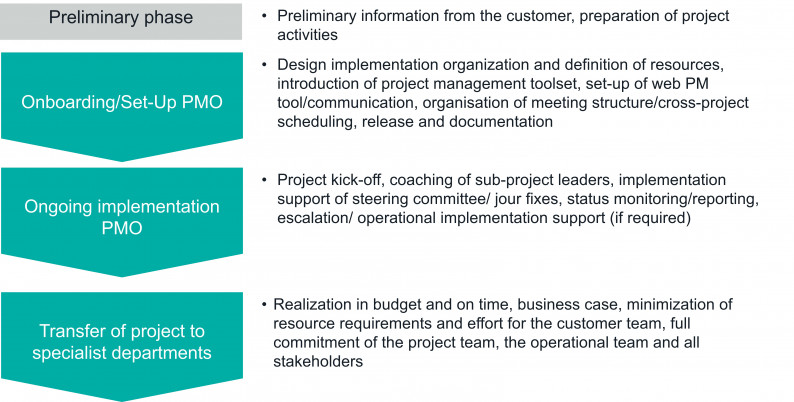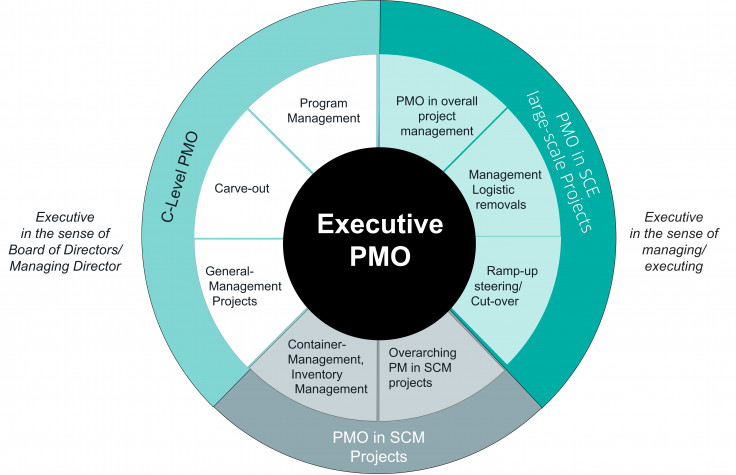

01.02.2023 | Written by Ole Grasedyck, Miebach
Without PMO it does not work anymore - established project approach in large projects
For some time now, the "Project Management Office" (PMO) has established itself in Supply Chain Engineering (SCE) alongside the classic project management approaches. The term "PMO" exists in the corporate world in a multitude of facets and different definitions. Basically, the PMO is a permanent institution in the company. In the case of projects, the term "Project Office" is generally used, which means that the focus is usually on project administration issues. Miebach Consulting uses the term PMO as an essential part of the project organization (and not "Project Office"), since it often concerns long-running large projects and therefore a PMO in the project also represents an institutional function with a permanent character. In addition to the administrative aspects, a PMO in large projects places a strong emphasis on the management component. Often, overall project managers in large projects are strongly technically oriented and it is therefore important that this gap in management is filled by a complementary PMO.
From Miebach Consulting's project experience in the design and implementation of a PMO as a relevant component of the project organization, the following potential benefits for the overall project can be highlighted:
PMO as part of the overall SCE project management leads to success
Conducting the information orchestra correctly - stakeholder management starts with transparency and communication."
A superordinate PMO focuses on transparency and communication in the entire client organization as well as control/coordination including accompanying peripheral projects. The client benefits from supportive coordination within major projects to program management. The focus is on the following topics:
Anchor overall project management as a central management function
The project management (PM) of the general planning has a strong executive character and includes, for example, topics such as quality assurance, overall schedule, budget control, management of change requests, interface coordination of the subprojects construction, intralogistics and IT, etc. The following figure shows an example of how the PMO together with the PM represents the overall project management as the central management function in the large-scale SCE project:

Fig. 1: Supplementing the executive project management with a PMO in the overall project management organization
Procedure Model
Know how - structured implementation with the PMO procedure model
The conception and ongoing implementation of the PMO at Miebach Consulting follows a proven standard procedure model:

Fig. 2: Process model for the introduction and implementation of a PMO
1. Conception
Conception of the PMO (set-up) - thorough preparation is critical for success
In the first phase of the project, the PMO is initially designed as an element of the overall project management (onboarding and set-up PMO). Here, a very strong coordination takes place internally with the technical overall project manager (PM) as well as with the PM of the client. Both PMs (internal/external) form a dual leadership, just as dual leaderships are formed in principle in all sub-projects below them. Experience has shown that this ensures that the best results can be achieved with regard to quality, costs and time in the implementation of the project. It is also possible that on the client side, if resources are available, a PMO dual leadership is installed. In addition to the PMO lead, it is also advisable to install a PMO admin, as a number of time-consuming and rather administrative activities arise later in the implementation phase, which are however important for friction-free implementation (e.g. ongoing change management with regard to the project manual and project management tools or budget controlling).
The design of the implementation organization (project organization chart) and the determination of the resources is crucial for the later success of the project. The content-related and organizational design of the subproject structure is iterative and it can take 2-3 months until the final project organization chart is in place. The sub-project structure and the management levels, including the steering committee and the steering board, are to be worked out in such a way that the large-scale project can later be implemented in a goal-oriented manner. Once the project organization has been agreed, the responsible employees are assigned to the subprojects (e.g. subproject managers) and all other project organization units. Experience shows that the selection and procurement of the right personnel resources is a very critical issue on the customer side. There is often a lack of qualification, experience and sufficient capacities. It is also often underestimated how high the effort will be in the later project implementation. Therefore, it is recommended to start staffing and recruiting as early as possible, since corresponding lead times have to be taken into account internally and externally. External employees, especially at subproject management level, often have to be recruited additionally. All sub-project managers as well as a large part of the project staff must be assigned full-time and, at a certain point, removed from day-to-day business. These gaps in the specialist departments have to be replaced by external people (often on a temporary basis). Since "human resources" is a critical topic and can also become critical from time to time during the course of the project, it is advisable to monitor this regularly via the (sub-project) status. The project organization chart is finally approved by the client or the management board and is binding for the further implementation.
The introduction of the project management tool set includes the definition and coordination of the required tools and templates (e.g. project status report). Here, "less is more" - the point is to enable project leaders to lead in a goal-oriented manner with few project management tools."
A list of open items (LOP) is an important management tool that should be used by the respective project managers. It has proven to be useful to use a continuous document for the respective meeting cycle and, in addition to tracking tasks, to also track decisions and information there in a timely manner as well as to communicate them. Often a handful of project management tools is sufficient and PMO is responsible for setting appropriate standards for the project as well as ensuring their implementation on an ongoing basis. In this context, the definition of the objectives, task packages and rules for the project organization and sub-projects is also carried out with the project specifications at sub-project level as well as the project manual for the overall project. Furthermore, risk management should be set up early and holistically and established as a relevant component of the subsequent implementation management.
The set-up of the web PM tool and the communication is also an important part of the implementation preparation. This involves the installation and design of project directories that can be accessed from any location, including all authorizations, as well as the coordination of web meeting and e-mail communication. It is essential that a structured and disciplined file and document storage is practiced from the very beginning. Furthermore, the PMO clarifies the change management instruments (e.g. project marketing as well as regular and case-by-case information of the employees in the company).
In the course of organizing the meeting structure, the structure of regular meetings such as jour fixe within the subprojects as well as regular meetings with the overall project management and subproject managers, interface meetings (especially between construction and intralogistics) as well as monthly steering groups and steering committees are developed. A goal-oriented meeting structure is one of the essential critical success factors in the subsequent implementation management. Here, the focus is on communication as well as leadership and information of all project participants. The core meeting is the weekly meeting in which the overall project management obtains the project status from the sub-project managers. Experience has shown that the short cycle of reporting on a weekly basis increases the quality of project management at all levels of the project and that the effort required for preparation, implementation and follow-up is kept within limits when the project is in a steady state.
The overarching project time planning is also set up in the conception phase and after kick-off an intensive coordination of all participants takes place here. The goal should be to adopt the project schedule for the duration of the project early after kick-off. The subsequent ongoing adjustments can be controlled by the PMO across the board.
Finally, the client (board level or overall project manager) approves and documents all defined project management content and rules for further implementation. All this is recorded in the project manual, which is subject to ongoing change management after kick-off.
2. Implementation
Ongoing implementation PMO - Ensuring implementation success through management
The project kick-off is a joint initiation of the project. All project-relevant employees and the project sponsor are involved. It is important that a positive mindset is created among all participants right from the start, since long-running projects also sometimes go through "difficult" phases and therefore the team spirit should be emphasized again and again. The kick-off is used as the first working meeting in the project implementation and first meetings afterwards are initiated. The most important excerpts from the project manual are presented and this is to be internalized as homework by all project participants. The project manual is the "basic law" for the further project implementation and represents the lever for the project managers to be able to lead the assigned project staff outside the disciplinary management possibilities of the company organization.
The PMO coaches the sub-project managers, e.g. in communication with the steering committee and in the use of project management tools. There is ongoing support in the implementation of meetings, professional sparring and, on a case-by-case basis, workshops.
The PMO accompanies the implementation at steering committee, steering board and jour fixe meetings. All relevant meetings are prepared, accompanied and followed up (events are transparently documented and recorded)."
The weekly or regular communication via status meetings, in which the relevant project management leadership levels report and exchange information, is the basis for the overall project management to make decisions and initiate escalations. Furthermore, this ensures the cascaded flow of information both upwards and downwards in the project organization. The overall project management should also meet at least once a week in a small circle in order to be able to discuss topics "off the record". Here, the focus shifts to ongoing stakeholder management in particular, which enables to quickly react to sudden disruptive influences . For their part, the subproject managers monitor their subproject team members independently in weekly jour fixe meetings, and PMO participates in these meetings on a case-by-case basis (e.g. for special topics). It is also important in this context that all managers in the project organization have deputies to ensure project implementation in case of absence. Experience shows that the areas in which the deputy arrangement is missing fall behind early on with regard to the processing of tasks, and the longer one waits in this regard, the more difficult it will be to close these gaps that have arisen.
An essential aspect of implementation management is status monitoring and reporting. Here, the individual status reports from the subprojects are brought together to form the status of the activities. Clear rules for setting the status (with regard to time, costs, quality and resources) as well as the presentation of the implementation progress, the next steps, the risks with countermeasures and the need for decisions create transparency and form the basis for the controlling intervention of the overall project management. The PMO's contribution to the project's success is usually also the proactive schedule control across all project phases as well as continuous project controlling. In addition to regularly querying and preparing subproject status reports, PMO queries the progress of subproject schedules and aggregates them into an overarching overall project schedule. In addition, the project schedule for the steering groups and steering committees is presented in a management-oriented manner. Postponements and changes to the project schedules are approved by the overall project management with the support of PMO.
Early escalation with regard to time, quality and costs in project implementation, ongoing risk management as well as support in the implementation of escalation measures (e.g. initiation of task force activities) is also an essential contribution of the PMO to the overall project success. In addition, ongoing special tasks such as cost monitoring or the review of invoices in project procurement can be taken over by the PMO admin.
3. Hand-over
Hand-over - permanent empowerment of the departments
In the fade-out phase at the end of the project, the project manual developed at the beginning is completed as a document and, if necessary, training documents are created. The handover and briefing of the employees of the specialist departments takes place. Here a briefing takes place in particular regarding the creation of regular reports and analyses and the PMO can accompany the first meetings and reports or analyses as a coach. A final presentation and the handover of tools and templates complete the handover.
PMO in large SCE projects
In addition to the PMO as a component of overall project management, the PMO is also installed in the management of logistical moves and in cut-over and start-up control projects. These are also overarching management activities that are required in supply chain engineering large-scale project implementation with regard to commissioning.
Executive PMO
Executive PMO - Solutions for top management and for complex large projects
Miebach Consulting summarizes all PMO activities under the term "Executive PMO". Here, on the one hand, "executive" is meant in the sense of board of directors or managing director, i.e. the addressee of the PMO is the top management in the company. On the other hand, "executive" in the sense of "leading, executing" clearly indicates the implementation character of the PMO in complex large-scale SCE projects. The following overview shows the individual executive PMO areas:

Fig. 3: Executive PMO - Overview of the different PMO facets at Miebach Consulting
With the C-Level PMO, Miebach Consulting supports the top management, among others in the implementation of larger programs. In the course of this program management, a number of sub-projects and workstreams are coordinated across departments for the implementation of a larger initiative in all management-relevant facets. For example, the integration of a product range acquired from a competitor requires a holistic approach that involves not only pure operations functions but also areas such as HR, sales, customer service and procurement.
In the case of a company carve-out and other transactions such as a merger or takeover, a superordinate authority is also required to steer all the issues that arise into the right channels of the project organization. In addition to the introduction of a powerful management and implementation organization, specialist expertise in the operations area is always mandatory at various points. For example, in the organization of processes and structures from ordering from the supplier to delivery to the customer in the new corporate structures, corresponding input is essential.
In connection with general management projects, for example, cost management topics (business case as a decision-making basis for major investments), group-wide HR process/structure optimizations and executive workshops are accompanied.
All supply chain management (SCM) topics should also be coordinated with a PMO from a certain size (PMO in SCM projects). Miebach also has proven expertise in container management - this usually involves large-scale company-wide projects across many locations, as the container cycles and interfaces to the suppliers can only be optimized holistically. Likewise, in inventory management, only a holistic and company-wide optimization approach that is centrally coordinated is usually effective.
Conclusion
Miebach Consulting sees great potential benefits for large-scale project implementation in the conception and implementation of a PMO, as both administrative and management-related gaps are closed with the goal-oriented addition of project management. Success has two letters: DO - major project management with PMO leads to your implementation success!
Are you about to launch a major project or do you have any questions or comments on this subject? Do not hesitate and feel free to contact us!
Author
